by Winding Pathways | Jul 16, 2020 | Garden/Yard, Mammals, Pests
What to Do About Raccoons
One June morning we peered out our dining room window to see bird feeder carnage. The shepherd’s hook that holds up suet and seed feeders were bent and the board it was anchored in shattered. The feeders were gone. One we later found in the little pond we have. We were frustrated and a bit angry.
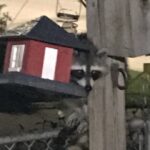
Raccoons are skillful climbers. (Jill photo)
Raccoons were the culprits. Several had raided the night before. Young raccoons are loved everywhere for their “cuteness”. We like them too, but damage can’t be ignored, so we took action.
Amazing Animals
Raccoons are amazingly successful animals. They live nearly everywhere in the continental United States and southern Canada. A few years ago, our son sent us a photo he snapped of a raccoon in a dumpster in our nation’s largest city. They thrive in urban, suburban, and rural areas, especially those that have streams, rivers, or lakes nearby and denning places. Those could be hollow trees, road culverts, or even barns, garages, and house attics.
Raccoons were released in Russia and Japan, where they thrive and are expanding their range. Away from North America they are an invasive species causing ecological problems and probably raiding chicken coops and bird feeders in their new countries.
What do Raccoons Eat?
They are successful, in part, because of their eclectic diet. True omnivores, raccoons enjoy dining on carrion, frogs, crayfish, mice, dog and cat food, birdseed, fruit, and a host of other things, even human food scraps tossed in trash cans.
How We Foil the Raccoons
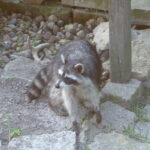
Raccoons forage wherever they find food.
We don’t want to physically harm the raccoons that damaged our bird feeding station so we are doing these things:
- Only put out as much seed as birds eat during the day, so night prowling raccoons find none to munch on. They move on.
- Bring silo, suet and hummingbird feeders inside each evening, so they’re not out to temp nocturnal animals.
- We don’t have a cat or dog but if we did, we would keep their food inside where raccoons cannot get to it.
- We close the sturdy doors that keep raccoons out of our chicken house at night. We’ve also installed heavy wire mesh over the coop’s windows.
- We feed food scraps to our chickens and compost what the hens won’t eat in a “tight” compost bin that raccoons can’t enter. Fortunately, chickens devour the foods raccoons love and shun foods that raccoons also don’t eat. If we had to put food scraps in the garbage, we’d keep the can in the garage where wildlife can’t access it.
Capturing the Culprit
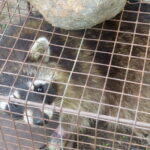
This raccoon readily entered the box trap to eat the sardines.
The night after the raccoons ruined our feeders, we did one other thing. We have a metal box trap that catches, but doesn’t harm, animals. We set it near the feeder with a sardine for bait. A big raccoon went right in. We let him stay there for a while so he could ponder his captivity. Then we sprayed him with water from the hose and opened the trap. He zoomed out like greased lightning, but he may have enjoyed the stay. It was a hot night and the hose water probably cooled him down. We hope he remembers being confined for a short while and stays away.
So far, these actions have worked. Our chickens are healthy and safe. And, no damage to feeders will happen when raccoons prowl.
by Winding Pathways | Apr 23, 2020 | Mammals, Nature, Reflections/Profiles, Uncategorized, Wonderment
A few months ago, we posted a blog honoring Smokey Bear on his 75th birthday. Smokey was created by the United States Forest Service in an effort to encourage people to be careful with fire. His was one of the most successful marketing campaigns in history.
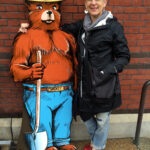
The allure of Smokey Bear.
Smokey is adorable yet commanding. When he said to drown campfires and snuff out cigarettes you did it without question. Today, we know that forest fires are a natural phenomenon with beneficial ecological impacts, but Smokey’s message still resonates.
Two Winding Pathways readers shared their memories of Smokey Bear.
Tracy McPartland of Cedar Rapids sent us a photo of her with Smokey taken at the Smithsonian. “I loved Smokey Bear as a kid. I used to voice imitate him even though I don’t know what his voice was like.”
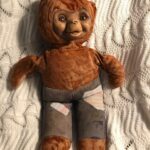
Smokey has been well-loved.
Jim Rainey is a retired US Army LTC who lives in Pennsylvania. Recently, he told us he received a Smokey doll from Santa in the early 1950s when he was four or five years old. “I was enchanted by Smokey. And, my doll still sits on the chair in my office. Sometimes my dog uses him as a pillow. At age 65, or so, he has patches on his jeans, is missing some hair, and part of his nose is gone. A few years ago, we asked our three daughters what they wanted of our stuff and was surprised when our oldest daughter said she wanted Smokey. Before then I was thinking of having him put in my casket, but I really didn’t want him locked in a box for eternity. I’ll let my daughter enjoy him and think of me,” he said.
Rich also has pleasant memories of Smokey and passed his image whenever he entered the Boise, Clearwater, or Idaho Panhandle National Forests during his college years. In 1974 he was a US Forest Service Hot Shot and fought three wildfires in Idaho. He’s kept a Smokey poster on his office wall for years.
There is confusion. Technically he’s Smokey Bear, not Smokey THE Bear.
A former college contact, the Fazio Family, owns Woodland Catalog Smokey Bear Gifts and has a store in Moscow, Idaho. Anyone wanting Smokey items can order it online. There’s a Smokey Bear museum in a state park in Capitan, New Mexico. You can take a brief virtual tour at
Smokey endures for the ages. His message is clear, and his presence is endearing.
by Winding Pathways | Feb 13, 2020 | Birds, Mammals, Nature
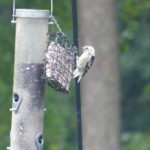
This Albino Woodpecker comes to the feeder regularly.
Several months ago, we looked out our dining room window and saw an unusual woodpecker enjoying suet at a feeder only a few feet away. It was a downy but it’s head was almost completely white, unlike all others of the same species we’ve seen.
Last year we had a fox squirrel with an unusually short tail that hung around our yard for months. We’ve also spotted other wild animals with distinctive markings unusual for their species, healed but visible wounds and other characteristics that help identify it as an individual.
The Power of Observation
Being able to identify an individual animal adds to the fun of wildlife observation. For example, from the squirrel, we learned that he or she mostly just stayed in our yard and nearby woods. We never spotted it at a neighbor’s yard. Then, one day we remarked, “We haven’t seen’ shorty tail’ for a while”. We actually never saw the animal again and assumed he or she met his end due to an accident, predator, car collision, or some other catastrophic incident. Because we could tell him from other squirrels, we know he lived at least ten months.
The piebald woodpecker still comes to our feeder, and we’re getting to know it as an individual rather than just a generic downy. It adds to the fun of wildlife observation.
Like people, animals are individuals. At first glance, every one may look the same but with careful observation, it’s possible to spot differences in plumage, fur, size, shape, gait, and even personality that help identify it as an individual. Scientists studying animals ranging from whales to snow leopards often learn to distinguish one from another by the pattern of barnacles on a whale’s body to the markings on a cat’s fur.
It’s a totally noninvasive way of distinguishing one from another. We can do this with common yard wild animals.
Do Squirrels Ever Fall?
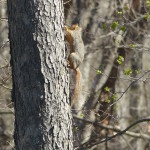
What happens when a squirrel falls?
Squirrels are amazingly agile, but they do slip and fall. It’s not common, but it happens. Rich has seen two squirrels fall from the top of large oak trees.
One squirrel lost its footing on a huge oak tree at the Indian Creek Nature Center when Rich was walking nearby. It spread out its legs and tail and fell horizontally, hitting the ground with a “thump”. Although it fell at least 40 feet the squirrel appeared uninjured, scampered off, and climbed right back up the oak.
Another squirrel fell from an even bigger oak in our home’s backyard. It did the same as the Nature Center Squirrel and spread out its body, hit the ground, and ran right off.
Squirrels rarely fall, but once in a while, they do. Fortunately, as this YouTube video shows, they seem amazingly able to recover from a fall that would instantly kill a human.
What are some of the animals you know as individuals? Let us know!
by Winding Pathways | Feb 6, 2020 | (Sub)Urban Homesteading, Mammals
One February morning I took a short work break and walked through the woods near a parking lot and a busy road. I wasn’t paying attention to where I was walking until I stepped on a hard-pointy object.
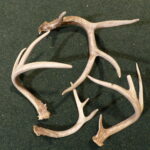
Finding a matching pair is unusual.
It was a huge deer antler that a buck had recently dropped. Finding it made my day and converted me into a shed hunter.
Shed hunting is a fun late winter activity that lets anyone hunt deer without the need to buy a hunting license. It is deer hunting without the need to kill an animal.
What is a deer shed?
All male members of the deer family and caribou females grow a new pair of antlers every year. They’re not horns. Sheep and goats grow horns, which stay on their head for life and are made of the same material as human fingernails. Antlers, in contrast, are bones of mostly calcium. They are the only bones that grow outside the body and are nourished by a blood-rich skin called velvet.
Why do deer drop their antlers?
Bucks begin growing antlers around April in most places. By September they are fully formed. They rub their antlers on trees to remove the no longer needed velvet, and the now polished bones are ready for jousts between males to figure out who’s the boss buck. By Christmas a dropping testosterone level causes the antlers to fall off. These “cast” or “shed” antlers can hit the ground as early as Christmas or as late as early April. But February is a prime time to search for them.
Where can I look for deer sheds?
Obviously, the best place to look for sheds is where deer hang out. Tracks, droppings, and actual deer sightings help locate prime places. In this modern era, some of the biggest bucks live in suburban and urban areas, so it’s possible to saunter out into the backyard and find one. Wooded city parks and timbered wooded corridors are also prime spots. Be sure to have permission before venturing on private land.
-
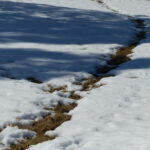
-
Deer walk the same path.
-
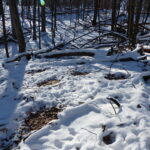
-
Sheds can be found where deer rest.
-
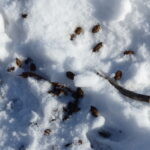
-
Follow trails of deer scat when shed hunting.
There’s more to shed hunting than we’re putting in this short blog. An outstanding resource is SHED HUNTING, A Guide To Finding White-Tailed Deer Antlers by Joe Shead (yup that’s his real name, and it’s pronounced “shed). For information check out www.goshedhunting.com/shop.
by Winding Pathways | Jan 5, 2020 | Birds, Mammals, Nature, Uncategorized
When the next soft snow falls, go tracking outside! A mid-December 2019 skiff of snow delighted us. There was not enough of the white stuff to shovel but the thin white blanket that covered our yard revealed who visited the night before.
The dimples of deer tracks were clearly visible as we went out to get the newspaper, but one set of tracks was unusual and especially interesting. Four footprints, in a rough line, kept repeating with about three feet of untrod snow between them. Just what animal created them?
-
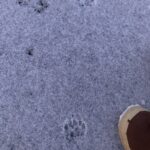
-
A skiff of snow is best for tracking.
-
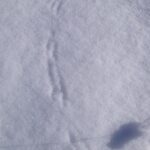
-
A small bird left tracks in the snow.
-
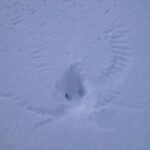
-
Gottcha!
After a bit of sleuthing, we decided it was a coyote out seeking a mouse or rabbit dinner. Coyotes aren’t rare around our home but they aren’t in the yard often. We wish we could have watched it lope across the yard.
A skiff of snow makes for a delightful walk in the woods, grasslands, or wetlands. Often animals are easy to spot as their dark coats contrast with the white snow and tracking is superb. It’s usually not hard to figure out what animal made the tracks, and following them gives some idea of what the animal was doing and where it was going.
Many Websites and books help with track identification but we like www.naturetracking.com because it shows tracks of animals most likely to be in a backyard.
Happy tracking.
-
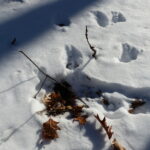
-
Squirrels at work.
-
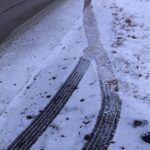
-
Even humans leave tracks all over.
-
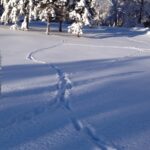
-
Deer paths are most obvious in deeper snow.
by Winding Pathways | Dec 26, 2019 | Birds, Mammals, Nature, Reflections/Profiles
We asked readers to send along some curious animal encounters.
Enjoy these guest blog entries as we wind down 2019.
From the East Coast to the Upper Midwest and ranging to Alaska and Hawaii people interact with or encounter wildlife in rural and urban areas.
Birds
SF: Lots to Raven About. “I saw my first ever raven yesterday — sitting and cawing on the roof of a car in a parking lot in Milford! JEESH! Do you think it was a portent of anything?
“Crows, of course, are extremely common; nevertheless, I love to see them in the huge groups they tend to gather in. I don’t know who assigned the collective nouns for species, but “Murder of Crows” is a favorite.
“Every time I hear that “caw” I look up hoping to see a raven, but I’ve never seen one until yesterday. I heard a ruckus as I got out of my car in a parking lot in Milford, NH, and saw one — sitting on top of a car and making his presence known. It was huge and oddly majestic, but sadly, it was a single bird, not an ‘unkindness of ravens’.”
AS: Birding Resort. Happenings were just ducky at a Hawaiian resort. And, this cock had something to crow about following a skeptical tourist. Who won? “The rooster lives near the food truck so it wins this match off.”
-
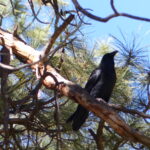
-
Ravens are huge and oddly majestic.
-
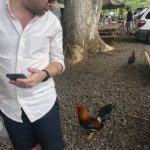
-
This rooster makes off great living near the food truck.
-
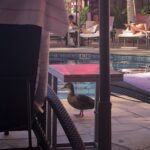
-
This duck wandered around the swimming pool at a Hawaiian resort.
JH: Eagle Encounter: Several years ago on my way to the Y swim class, I saw, to my total delight, a wondrous sight. As I approached my turn, I saw a huge bird just sitting on a fence post. I made the turn and slowly stopped my car, I recognized this critter as the American Bald Eagle. We each sat on our own perch eyeing one another. After carefully retrieving my camera, I snapped a couple of pictures.
The eagle kept an eye on me. Then, he spread his wings and laboriously lifted off, swinging to his left towards a telephone pole out in the pasture. As he landed, he tucked his wings into his sides and continued his watch. I suppose he was wondering what I was doing just as I was wondering what he had been doing as he sat on the fence post.
He had been just a couple of arm’s lengths from me. To be so close to him was awesome. I could only imagine what it would be like to stroke his beautiful feathers.
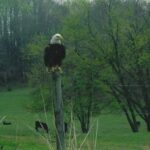
The eagle continued to eye me.
Mammals
JA: Albino deer. I caught some photos of albino deer in Wisconsin.
DP: Surprise Dolphins. “While reporting from Charleston, South Carolina, during the 2012 presidential campaign my colleagues and I stopped to look at the ocean. The city is surrounded on three sides by water and we expected to see lots of boats and people enjoying the water. We didn’t expect to encounter a school of dolphins! They swam around us for a few minutes and seemed to be having a lot more fun than we were.”
-
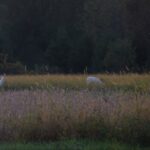
-
Two albino deer in a field.
-
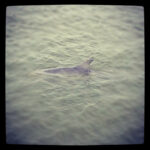
-
Dolphin in a harbor.
NP&BO: Moose & Wolverines & Cats! Oh, my! Baby moose roaming an Anchorage neighborhood, munching on raspberry patches. Then, along comes mama and they stroll down the street. A lot of urban moose in Anchorage. Other parts of the city boast moose and black bears!
News from the North. Latest Anchorage crime as reported by the Anchorage Daily News: Yet Another Urban Wildlife encounter as cat survives wolverine attack near the Campbell Science Center.
-
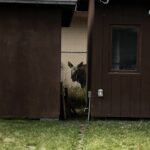
-
A curious calf moose looks across the lawn.
-
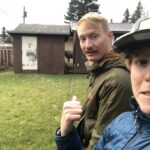
-
Munching raspberry bushes in the back yard.
-
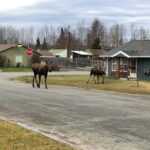
-
A curious calf moose looks across the lawn.
-
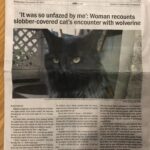
-
Strange things are seen in the land of the Midnight Sun.
North Woods Near Encounter
MN: Wolf Encounter. “My friend and I were camping in the BWCA in January, several years ago. At the end of a long day of cutting/splitting wood, fishing, snowshoeing and cutting more wood, we sat next to a blazing fire as the early sunset arrived and we were soon enveloped in darkness. The stillness of the forest in winter is amazing because there are no insects or other nocturnal creatures that make noise. On this windless night, there was no sound besides the crackling fire. Suddenly and without warning, we both had the feeling that someone or something was watching us from not far away. I slowly turned, and the fire was just bright enough to illuminate the face of a large wolf, 10 feet away. We froze, not knowing what to do. Had it been a black bear in summer, we would have started shouting and waving our arms to scare it away. But we weren’t prepared for this and had no idea what to do. So we just sat and watched. The wolf didn’t seem aggressive, and it slowly moved directly toward me. I remained motionless. It came right up next to me and sniffed my arm. I wondered, what I should do? I was a little too unnerved to do anything. The wolf seemed satisfied with my scent and moved on to my friend and smelled his boot. And then, just as quietly as he arrived, he slowly walked off into the woods. We sat there motionless, except for our eyes, all four of which were now the size of half dollars. We threw some more wood on the fire and waited, but the wolf did not return.
Mystery Solved
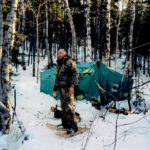
Comfortable digs on a winter campout.
“The next morning we got up and went out to fish. In the distance, on the other side of the lake, we saw someone doing the same. We decided to take a walk and share our wolf experience with this person. We greeted him and explained what happened and asked if perchance he had encountered the same wolf. He had indeed! And suddenly the wolf was bounding across the ice, coming straight for us. “Max, come on boy! Over here!” We were astounded that this guy was actually naming and calling wolves. “Do you know this wolf?”, we asked. He knew him all right. He owned this “wolf”, which was actually a mix – half-wolf, half-dog! We petted him and he licked our bare hands just as any dog would, especially since he was familiar with our scent after his visit to our campsite the previous night.”
Erma Herman Visits During a Cold Canadian Night
LF: Erma Herman. Though not snuggly, ermine are quite lovely little critters. Their Winter coat seems more purely white because of their black tails, bright black eyes and button nose. For several Winters I’ve enjoyed watching one that has visited our platform feeder to gnaw on the chunk of suet I put out for the birds. I marvel at the rapid movement, dashing back and forth, here one second, gone in a flash.
I’m guessing it’s one, as I’ve never seen two at the same time.
Last Winter, during a freeze/thaw period, after we had some plumbing issues that involved the plumber working in the crawl space under the house, we were visited by ‘Erma Herman’ in the middle of the night. I awoke to an alarmingly loud, squeaking/squealing sound coming from the kitchen and the cat “tharumping” across the floor, coming to a halt in front of the dryer, where I could see a tiny black nose poking out from underneath.
It had found its way in through the smallest of openings left by the plumber, making its way up the hoses for the washing machine and into the kitchen where the scent of cat food was calling. It took several nights, a mousetrap, which is still somewhere in the understructure of the house, several packages of steel wool and a roll of duct tape (Red Green would be proud) before it stopped coming in.
My neighbour, who no longer tries to keep chickens, is not a big fan of ermine, Winter or Summer.
-
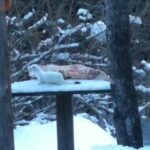
-
An Ermine climbed up and began gnawing on suet.
-
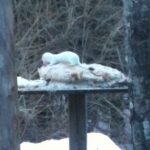
-
A white Ermine on the sudet feeder in Canada.






























